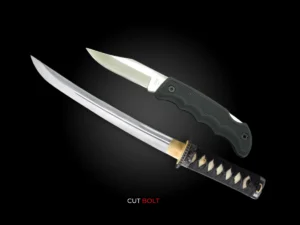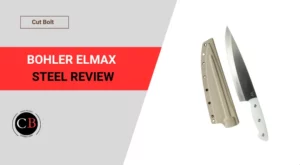As a seasoned enthusiast of blades and steel, I’ve traversed the vast landscape of knife craftsmanship, seeking the perfect balance of durability, sharpness, and edge retention. Amidst this journey, one steel alloy has consistently captured my attention: CPM 154.
The obvious question remains – “Is CPM 154 steel good for knives?”
I am a knife aficionado who’s put CPM 154 through its paces, from campsite carving to city EDC, I’ve got stories (and nicks) to share. Dive deep with me to uncover the truth about this popular steel: its edge-holding secrets, surprising resilience, and yes, even its not-so-perfect side. So, whether you’re a seasoned steel nerd or just starting your knife journey, buckle up – the tale of CPM 154 is about to unfold.
CPM 154 – An overview
Many knife manufacturers use CPM 154 for their premium knives. Brands like Kershaw, Hogue and Bark River use it extensively.
154 CM stainless steel has long been a sought-after metal for knife manufacturers. The addition of molybdenum to 440C steel gave CPM 154 knife steel (datasheet: here) far better edge retention while maintaining corrosion resistance. CPM 154 and its “twin,” ATS-34, are not without specific drawbacks, however. Knifemaker John Barlow explained to Blade Magazine why he switched to CPM 154 for his knives.
I started with 440C stainless ages ago. Almost 20 years ago I gave up that and switched to ATS-34 stainless steel, which I also used for years.
John Barlow
Structurally the metal was perfectly fine, but fussy knife makers who had been using 154CM and ATS-34 for decades were starting to notice the same. John decided to use CPM 154 and never looked back.
He recognized CPM 154 knife steel as a material that enabled flawless processing. The problem of “abrasions” was eliminated with the powder metallurgical process and the associated uniform distribution of the hard metals.
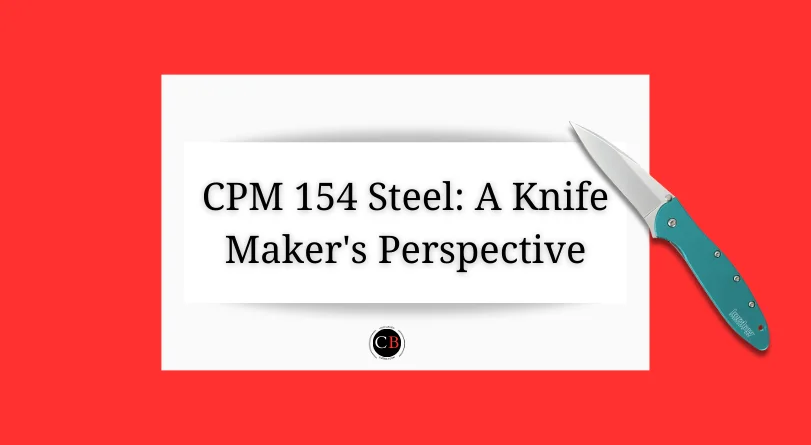
What is CPM 154 knife steel?
Crucible Particle Metallurgy (CPM) steels are formed by forcing molten metal through a small nozzle where high-pressure gas atomizes the liquid stream into tiny droplets. These droplets are cooled, solidified into powder, and then hot isostatically pressed (HIP), which binds and densifies the powder.
The result is a more homogeneous mixture of extremely fine particles.
When this is done at a very high level you can’t even see the grain of the steel anymore. This also helps with grinding and polishing while providing better corrosion resistance, wear resistance, toughness, and hot hardness compared to 440C.
Chemical composition of CPM 154 knife steel
CPM 154 steel contains the following chemical elements in addition to the basic ingredient iron in these amounts:
| Element | Portion | Effect |
| Chrome | 13.47% | Improves wear resistance, heat resistance and scale resistance. It increases tensile strength because it acts as a carbide former. Use of rust-proof or stainless steel, as it increases corrosion resistance from a mass proportion of 12.2%. Reduction in weldability. |
| Carbon | 1.06% | Increasing hardness and tensile strength. In larger quantities, increase in brittleness and reduction in forgeability and weldability. |
| Copper | 0.09% | Improving weather resistance (surface oxidation). |
| Manganese | 0.51% | Improves hardness and tensile strength. |
| Molybdenum | 4.01% | Improves hardenability, tensile strength and weldability. Reduction in forgeability and ductility. |
| Nickel | 0.16% | Nickel increases tensile strength and yield strength. From 8% increase in corrosion resistance. |
| Phosphor | 0.02% | Increases tensile strength, hardness and corrosion resistance but also brittleness. |
| Sulfur | 0.02% | Increases machinability but also brittleness. |
| Silicon | 0.84% | Improves strength. |
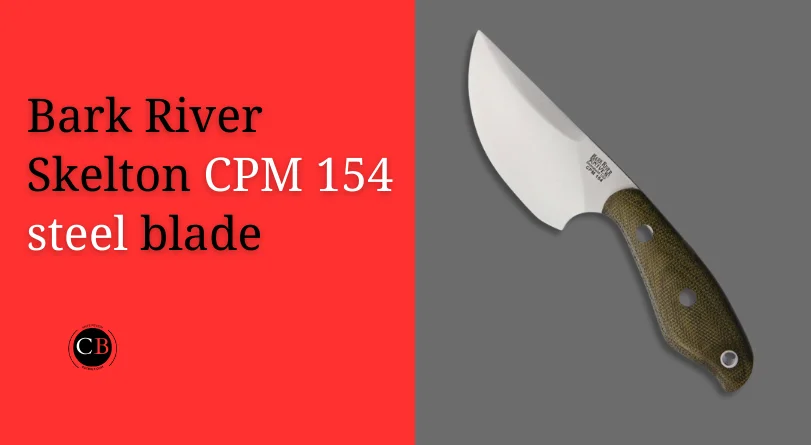
What is the hardness of CPM 154 knife steel?
CPM 154’s hardness typically falls within the range of 58-63 HRC (Rockwell Hardness). This makes it a relatively hard steel, offering good edge retention and wear resistance. However, the exact hardness achieved impacts other properties like toughness and ease of sharpening.
Here’s a breakdown:
- Lower hardness (58-60 HRC): More tough and chip-resistant, but might require slightly more frequent sharpening.
- Higher hardness (61-63 HRC): Holds an edge for longer but may be slightly more prone to chipping if stressed heavily.
CPM 154 steel has the highest hardness of 63, however, in general, the average hardness for knife-making is aimed at 58-60.
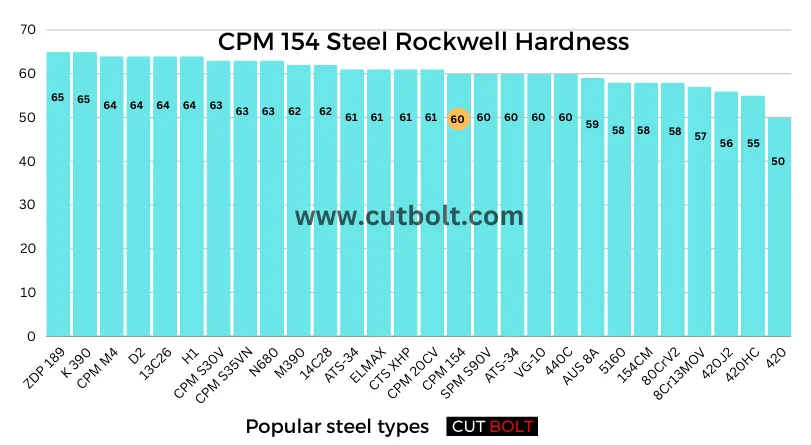
How to heat treat CPM154 steel?
CPM 154 utilizes a specific heat treatment process to achieve its desired properties. Here’s a breakdown of the key steps:
1. Annealing:
- Heat to 1650°F (900°C) for 2 hours.
- Slow cool at a rate no faster than 25°F (15°C) per hour to 1200°F (650°C).
- Furnace cool or cool in still air to room temperature.
2. Preheating:
Heat to 1400°F (760°C) to ensure even temperature distribution throughout the steel.
3. Austenitizing:
This is the crucial hardening step, where the steel is heated to a specific temperature range:
- 1900-2000°F (1037-1093°C): Standard range for good balance of hardness and toughness.
- Higher temperatures (up to 2025°F): Can achieve higher hardness (63+ HRC) but potentially sacrifices toughness.
- Hold at the chosen temperature for 30-60 minutes.
4. Quenching:
Rapidly cool the steel to prevent the formation of softer structures:
- Oil or positive pressure quench: Common methods, achieving hardness around 58-60 HRC.
- Salt quench: More aggressive, reaching higher hardness but requiring specialized equipment.
- Cool the steel below 125°F (50°C) to complete the transformation.
5. Tempering:
Heat the steel multiple times (typically twice) at lower temperatures (400-550°F) for 2 hours each.
This relieves internal stresses and improves toughness without significantly sacrificing hardness.
Additional Note:
Cryogenic treatment (freezing to extremely low temperatures) can be used after quenching for further refinement of the microstructure and potential improvement in toughness and wear resistance.

Recommended heat treatment for CPM 154 steel:
Transforming all retained austenite in CPM 154 requires a cryogenic treatment, typically involving dry ice (-100°F/-74°C). This can be done either immediately after quenching or between tempering cycles
However, complex shapes with sharp corners benefit from the added safety of applying the treatment between tempers. Notably, thin sections can achieve similar results through forced air quenching.
Remember, the specific timing and method (dry ice vs. specialized cryogenic facilities) should be chosen based on the complexity of your piece and access to resources. Do not forget to check CPM 154 steel datasheet.
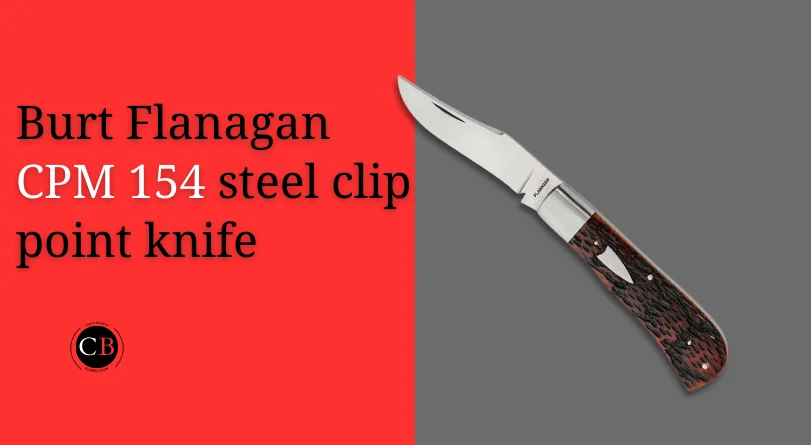
Comparison CPM 154 – 154CM steel
While both CPM 154 and 154CM share the same basic composition and excel in knife making, there are subtle distinctions to consider:
Manufacturing Process:
- 154CM: Traditional ingot metallurgy, leading to larger carbides and potential inconsistencies.
- CPM 154: Advanced particle metallurgy, creating finer, evenly distributed carbides, potentially enhancing:
- Polishing: Easier to achieve a mirror finish.
- Heat Treatment: More consistent and predictable results.
- Toughness: Improved resistance to chipping and breaking.
Other Key Points:
- Hardness: Both aim for 58-60 HRC, offering good edge retention and wear resistance.
- Magnetism: Both are magnetic due to their martensitic nature.
- Comparison to 440C: Both CPM 154 and 154CM outperform 440C in edge retention, chip resistance, and dimensional stability.
- Machining: Similar machining parameters for both and other knife steels like ATS-34.
Choosing Between Them:
- If cost is a primary concern: 154CM might be slightly cheaper.
- If you prioritize ultimate performance and consistency: CPM 154 might be worth the upgrade.
- For most everyday knife uses: Both steels offer excellent performance.
Both steels have the same properties, but CPM 154 is the particle metallurgy version. 154CM was first developed in the 1970s for jet turbine blades, so it is a fairly high-quality steel. The “C” in CPM stands for the name of the manufacturer (Crucible Industries), CPM 154 is ultimately just a reissued version of 154CM, but in a more advanced (some would say “cleaner”) version of the steel.
CPM 154 is a martensitic stainless steel, which has less chromium and very little nickel compared to austenitic steels. This also makes it magnetic. Martensitic steels have a higher carbon content, which allows for the formation of martensite, an extremely hard structure that makes it ideal for knife-making.
CPM 154 is easier to polish to a mirror finish and easier to grind than CPM S30V (more on that in this article). However, the CPM process is one step ahead of 154CM in another discipline: powdered steels can be heat treated with maximum effectiveness.
Compared to 440C, the standard against which most stainless knife steels are measured, CPM 154 exhibits better edge retention, chip resistance, as well as dimensional stability. The general machining parameters are similar to 154 CM, ATS-34 (Hitachi) and 440C.
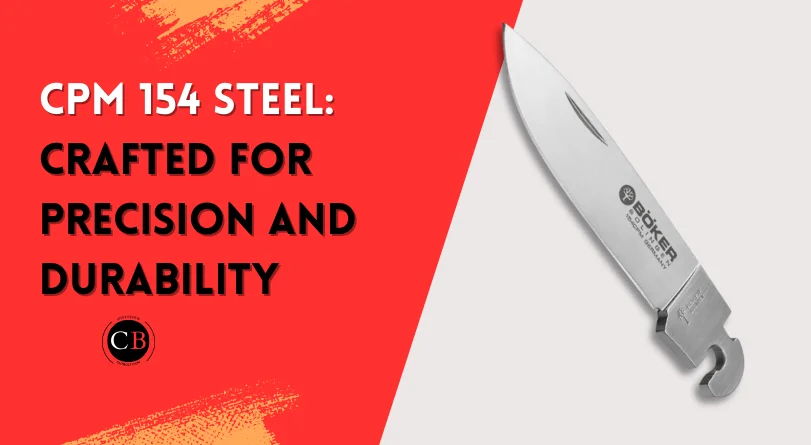
Is CPM 154 a good steel for knives?
CPM 154 is a solid choice for knife steel, offering a desirable balance of good properties that make it suitable for a variety of uses. Here’s a breakdown of its strengths and weaknesses:
Strengths:
- Good edge retention: Holds a sharp edge for a reasonable amount of time before needing sharpening.
- Decent toughness: Resists chipping and breaking, especially with proper heat treatment.
- Corrosion resistance: Stands up well to moisture and sweat, making it practical for everyday use.
- Ease of sharpening: Relatively easy to sharpen compared to some high-performance steels.
- Polishing potential: Takes a nice polish for a smooth and aesthetically pleasing finish.
- Good machining characteristics: Relatively easy to work with for knifemakers.
Weaknesses:
- Not the absolute best in any single category: Some steels excel in specific areas like edge retention or toughness, but CPM 154 doesn’t necessarily top the charts in any one aspect.
- Slightly lower corrosion resistance than some other stainless steels: While decent, it might not be ideal for highly corrosive environments.
- Not the most wear-resistant option: May show wear faster than some steels under heavy use.
Overall:
CPM 154 is a versatile and well-rounded steel that makes it a popular choice for many knife applications. It’s particularly suitable for those seeking a balance of edge retention, toughness, ease of use, and aesthetics. However, if you prioritize absolute dominance in a specific area like edge retention or wear resistance, other steel options might be worth exploring.
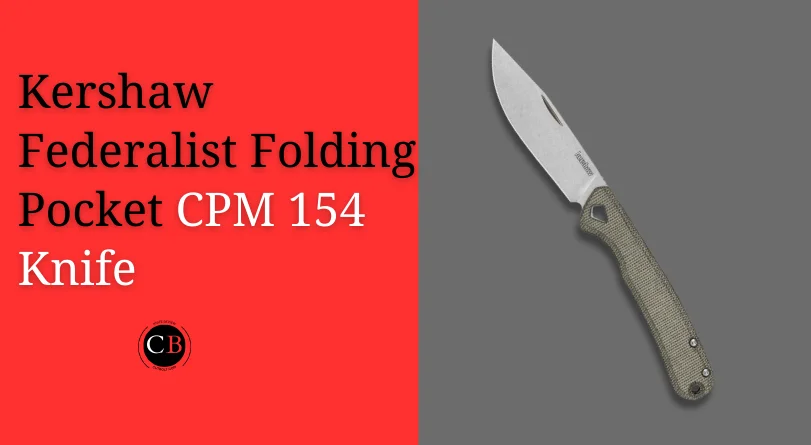
Conclusion: Is CPM 154 steel good for knives?
Knives manufactured today are truly technological marvels compared to their “ancestors.” CPM 154 is one such “miracle” material, as it is far superior to many of the steels in use today. It is a jack of all trades – easy to machine, yet retains its outstanding properties in terms of machinability, edge retention, corrosion resistance and sharpenability.
Manufacturers using CPM 154 have found this steel to be a nearly perfect material for making great blades. CPM 154 “ticks all the boxes,” as the saying goes, delighting users and collectors alike.
Its success story begins with a very good steel, 154 CM, which, in terms of workability and user-friendliness, is taken to the next level. In any case, CPM 154 will certainly be found in knives of all possible applications for a very long time.

